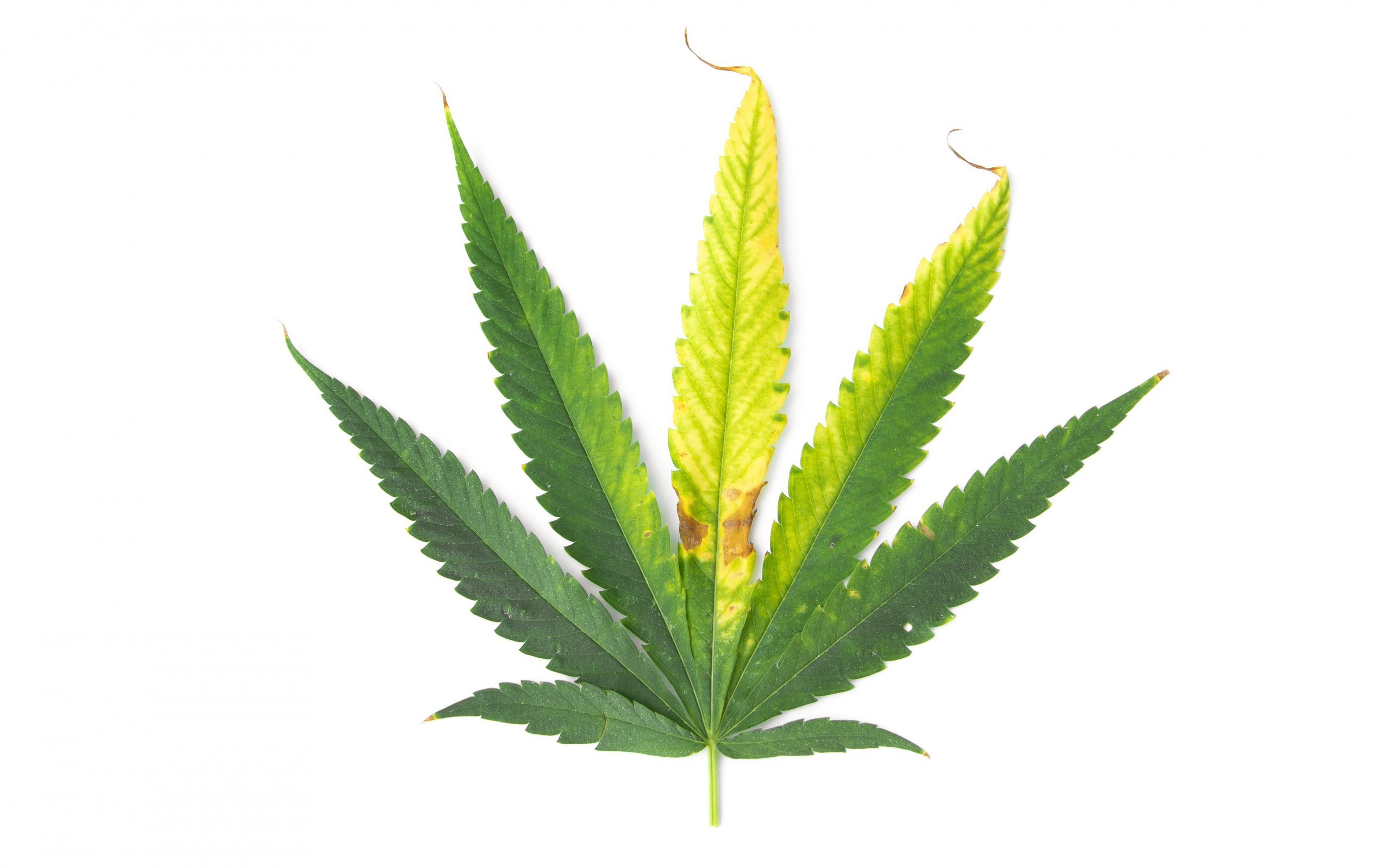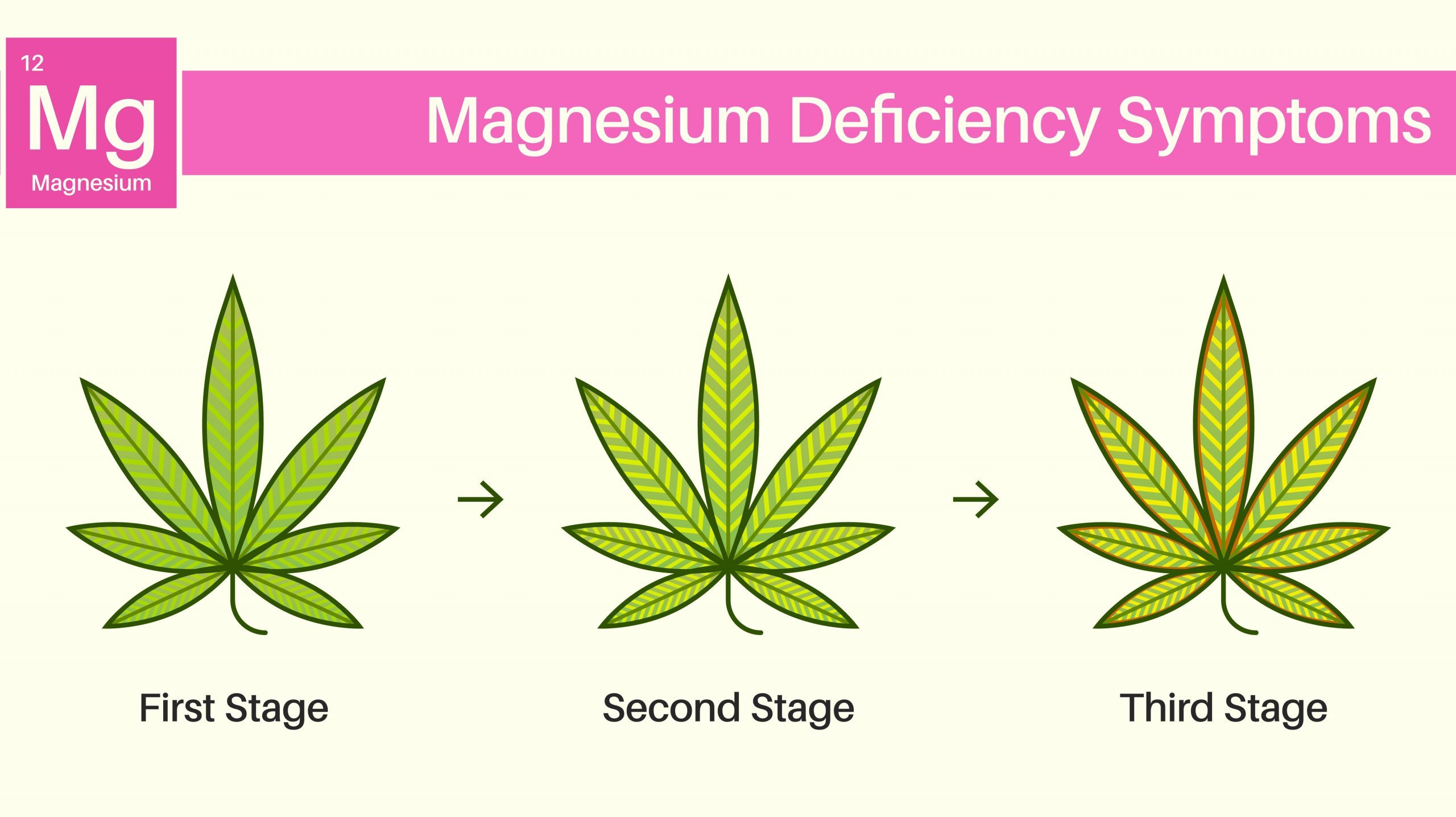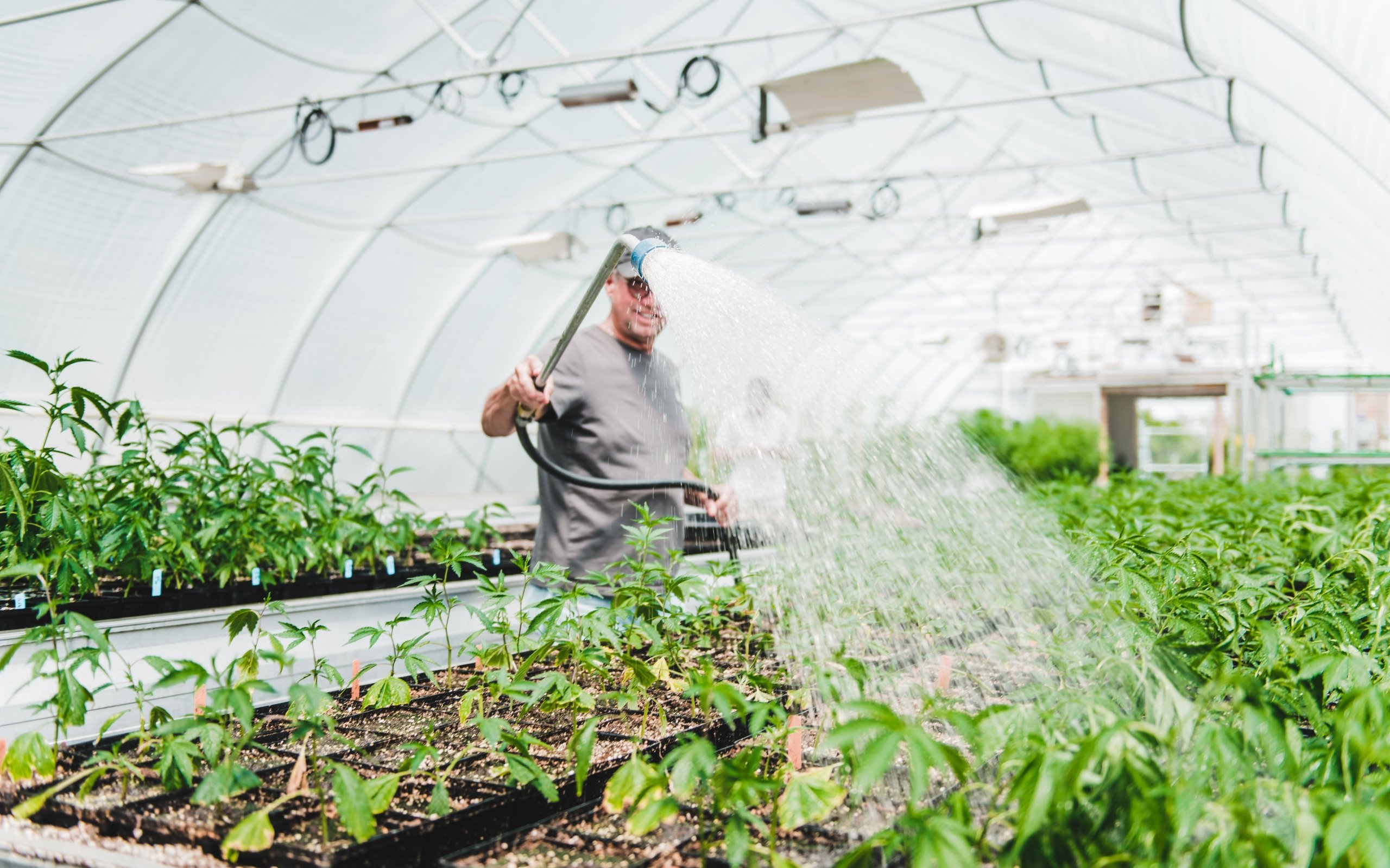Preventing & Fixing Magnesium Deficiency in Cannabis Plants
Magnesium is essential in all the stages of plant life. It is the core element of chlorophyll, which plays a crucial role in photosynthesis. With severe magnesium deficiency, weed plants will eventually die.
Cannabis plants need proper nutrients and water to sprout, grow, and mature. The main elements for weed crops are nitrogen, potassium, and phosphorus. There are about 25 others that marijuana plants need to survive, one being magnesium.
It’s an essential nutrient (nute) for cannabis leaves to produce chlorophyll through photosynthesis, providing its rich green color. One of the first signs of a lack of magnesium in your cannabis crop is discoloration.
A magnesium deficiency in weed can be detrimental to the health of your marijuana harvest. If you’re a weed grower and think your cannabis seeds and crop are suffering, don’t worry. There are ways to cure your problem and continue growing marijuana seeds.
Continue reading to find out more.
What is magnesium deficiency?
Magnesium (mag) is a crucial secondary nute for cannabis plants. Your weed crops need it to perform photosynthesis, how your marijuana plants convert sunlight into chemical energy.
When there is a cannabis plant magnesium deficiency, the weed leaves can’t absorb sun rays and grow. This shortage starves the bud plant of nutes.
You’ll begin to see the yellowing of the oldest and lowest marijuana leaves. Your cannabis crop may never make it to the flowering stage.
Magnesium is mobile within the cannabis harvest, which means the element moves throughout the stem and leaves. Even in healthy plants, the more robust leaves send magnesium to the new growth areas, and it will circle back around.
This can cause a deficiency to affect a large amount of the cannabis plant in a short amount of time.

What puts your plants at risk of magnesium deficiency?
As a marijuana grower, you might be reading this and thinking, “Shoot, I don’t want this to happen to my buds!” Put the joint down, don’t stress. Well, take a hit and get back to reading.
Some environments put your cannabis plants at more risk for a magnesium deficiency in weed. If you know what to be mindful of, you’ll reduce the likelihood of problems.
Marijuana farmers favor coco coir as a weed-growing medium. It comes from the middle fibrous part of the coconut. The problem of nute deficiency is more likely with coco coir.
Magnesium, along with iron and calcium, is one of the elements that is difficult for cannabis seeds and roots to absorb with coco coir medium harvesting.
Soil and other mediums with a pH imbalance are prone to cannabis magnesium deficiency. If the environment is below five or too acidic, the marijuana roots can’t absorb the nutes.
If you’re overwatering, this can flush out nutrients from the growing medium, which results in mag deficiency in cannabis and other elements. The pH will be more neutral, and the roots will be soggy.
What are the symptoms of magnesium deficiency in weed?
You can determine a marijuana magnesium deficiency by the appearance of the leaves and stems. Magnesium is a vital part of producing chlorophyll, so discoloration is a key magnesium deficiency symptom in cannabis seeds or roots.

Yellow leaves
A healthy weed leaf is dark green. If you’re seeing your cannabis crops fading into light green or yellow, you likely have a magnesium deficiency in weed. The first leaves to be affected will be the larger ones and those closest to the bottom.
The big marijuana leaves will mobilize their excess magnesium and send it to the new growth. They’ll continue doing this until they run out of supply and start turning yellow.
The ones at the bottom of the cannabis plant send nutes to the top as the roots absorb magnesium. The weed leaves near the soil will give all of their nutrients first until they’re deficient.
Keep an eye on these areas for symptoms along with the rest of your cannabis plant. As the problem gets worse, more leaves will be affected and go from yellow to brown. Eventually, they’ll be dry and fall off the plant.
You should aim to fix the problem before this stage.
Red stems
Stems are like the highway for nutrients to travel from bottom to top. If you have a flat tire, an essential part of the car, you can’t continue driving. You can create a traffic jam, and the highway can’t work correctly.
If you’re missing a vital nutrient, magnesium, the whole function of the cannabis plant can’t work. As soon as you see signs of cannabis nutrient deficiency on the stems, they won’t provide nutes to the leaves.
Stems will start to turn a reddish-purple, beginning from the roots to the base of the cannabis plant. Keep an eye on this area of the weed crop to ensure it’s healthy. It should be dark green.
Keep in mind some cannabis seeds and plants naturally have red stems. Know which marijuana strains you’re buying and be aware of their characteristics.
How to tell if you have cal-mag or mag deficiency?
Munchies are to a weed smoker as calcium is to magnesium in your cannabis plant. Calcium and magnesium deficiencies often appear together, resulting in a cal-mag deficiency in weed. If you’re having a problem with one element, others are likely out of balance too.
Sometimes, it’s hard to precisely tell which nute your cannabis plants lack because the symptoms are similar for deficiencies. It’s possible to confuse one for another.
Calcium is an immobile element that helps nitrogen and sugar flow through the cannabis plant. A sign of a calcium deficiency in cannabis is the lower leaves curl and turning yellow with brown edges.
You’re probably thinking, but that’s the same as a mag deficiency. If you’ve already amended your soil to fix a potential cannabis nitrogen deficiency, calcium should be the next thing you check.
The difference is that magnesium is mobile. The yellowing might begin towards the bottom, but it will travel quickly. You could see discoloration at different parts of the cannabis plants, while a calcium deficiency will stay towards the bottom.
If you’re still unsure which one it is, you can benefit from buying a fertilizer with a calcium and magnesium mix.

How to differentiate between magnesium deficiency and other nutrient deficiencies
Magnesium is the central element in all chlorophyll molecules. If the most significant red flag you see is the yellowing of cannabis leaves at a fast rate, you can feel confident that you have a mag deficiency in weed.
The lack of chlorophyll, which gives the green color to the cannabis plant, will fade into a yellow or brown color among the leaves.
The malnutrition of other elements will affect different parts of the weed plant. For example, a cannabis iron deficiency will show in young growth and is semi-mobile. Iron is a catalyst for chlorophyll production, so there will be discoloration.
While manganese deficiency symptoms are yellowing of weed leaves, the veins remain green with dead spots on the plant. It also affects the new leaves first.
You can determine a magnesium deficiency because it affects mature marijuana leaves first as opposed to new growth.
How to fix magnesium deficiency in cannabis
Oh no! Do you think you have a magnesium deficiency in your cannabis plants? If you catch it early enough, you can help save your marijuana crop.
To understand the root of the problem, you should do some tests in the growing medium. Examine the pH level, the current nutes levels, and the wetness of the medium. Pinpoint the issue and act accordingly.
How to fix magnesium deficiency? Follow our advice, and you’ll be back to weed growing with healthy cannabis seeds in no time.

Flush your plant and upgrade your nutrients
If you’re suffering from a pH or nutrients imbalance, you need to flush your cannabis plant and then add in nutrients.
When a growing medium is too acidic, adding clean water will help it get to a proper pH level. You’re looking to be in the ideal range of 5.5 to 6.5. When you flush, you take away the acids and, along with it, the nutrients.
Once you achieve a proper pH, up the nutes to promote marijuana seeds and roots to grow, you can purchase a balanced nutrient mixture and use that.
Magnesium toxicity in cannabis happens when there is too much. You want to make sure all elements are balanced, not just the problematic ones. Try using the Homegrown marijuana nutrients for a high quality feed for your cannabis plants.
If you’re choosing to use coco coir, you can up the amount of magnesium you give. A quick fix is to mix magnesium sulfate, known as Epsom salt, with water. Spray extra nutes to your cannabis crops to ensure you don’t have a magnesium deficiency in weed plants in the future.
Flush your plant and add supplements
When the problem is from overwatering, so the marijuana growing medium is too depleted of nutes to provide to the plants, you should flush and add supplements.
Flush your plant first to give your cannabis seeds and plants a fresh start. Then, add perlite or vermiculite to the soil or medium. Perlite is a volcanic rock, and vermiculite is a spongy substance produced from a silicate material.
These both work to absorb excess water and can release when the cannabis growing medium needs more moisture. This will ensure the marijuana roots aren’t too wet or dry and can adequately receive and give nutes to the rest of the cannabis plant.
We recommend using the Homegrown marijuana nutrients to replenish the supplements in your growing medium. It’s designed for cannabis plants, so it gives them the correct amount of each element to avoid a deficiency.
Preventing a magnesium deficiency in the future
Once you fix your magnesium deficiency, you’ll want to make sure this doesn’t happen again in the future. There are a few things you can do to help prevent it.
A magnesium deficiency in marijuana plants is more common in coco coir, so avoid using this growing medium until you’re a little more experienced.
Keep an eye on the pH levels of your marijuana plant. Remember if it’s too acidic, the roots can’t absorb the proper nutes. Testing the acidity regularly will ensure your cannabis plant is able to grow to its full potential.
Another common cause of magnesium deficiency is overwatering. Try reducing the amount of water or how often you’re watering to ensure there’s enough nutrients in the growing material. Replenish the elements with Homegrown marjuana nutrients for the best results.
If you keep an eye on these areas, you’ll be less likely to have a magnesium deficiency problem.
Final thoughts about magnesium deficiency
If you’re experiencing a magnesium deficiency in marijuana and the signs are visible, you won’t be able to save the damaged weed leaves. Instead, you’re trying to keep the healthy marijuana crops from being depleted.
You’ll want to prune the discolored leaves and stems to allow new growth. Don’t be discouraged if you’re experiencing a magnesium deficiency in weed. It can happen to even the most experienced cannabis growers.
How to fix magnesium deficiency in plants? Now that you know what to look for and how to cure a mag deficiency. Go look at your marijuana garden. Check to see if everything is healthy and fix problems immediately if you catch a glimpse of yellowing.
If you lose many cannabis crops, you can buy new marijuana seeds and begin growing again. You’ll learn from the experience and have even more successful harvests in the future.
Happy growing!
About the Author: Kyle Kushman
Kyle Kushman is a legend in the cannabis community. He is the modern-day polymath of pot: cultivator, breeder, activist, writer, and educator. After winning no less than 13 Cannabis Cups, there’s nothing this guy doesn’t know about indoor growing - he’s been there, done it, and is still doing it to this day!